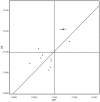Strontium isotope signals in cremated petrous portions as indicator for childhood origin
- PMID: 25010496
- PMCID: PMC4091946
- DOI: 10.1371/journal.pone.0101603
Strontium isotope signals in cremated petrous portions as indicator for childhood origin
Abstract
Dental enamel is currently of high informative value in studies concerning childhood origin and human mobility because the strontium isotope ratio in human dental enamel is indicative of geographical origin. However, many prehistoric burials involve cremation and although strontium retains its original biological isotopic composition, even when exposed to very high temperatures, intact dental enamel is rarely preserved in cremated or burned human remains. When preserved, fragments of dental enamel may be difficult to recognize and identify. Finding a substitute material for strontium isotope analysis of burned human remains, reflecting childhood values, is hence of high priority. This is the first study comparing strontium isotope ratios from cremated and non-cremated petrous portions with enamel as indicator for childhood origin. We show how strontium isotope ratios in the otic capsule of the petrous portion of the inner ear are highly correlated with strontium isotope ratios in dental enamel from the same individual, whether inhumed or cremated. This implies that strontium isotope ratios in the petrous bone, which practically always survives cremation, are indicative of childhood origin for human skeletal remains. Hence, the petrous bone is ideal as a substitute material for strontium isotope analysis of burned human remains.
Conflict of interest statement
Figures





References
-
- Hillson S (1996) Dental anthropology. Cambridge: Cambridge University Press.
-
- Schweissing MM, Grupe G (2003) Stable strontium isotopes in human teeth and bone: a key to migration events of the late Roman period in Bavaria. J Archaeol Sci 30: 1373–1383.
-
- Dolphin AE, Goodman AH, Amarasiriwardena DD (2005) Varia-tion in elemental intensities among teeth and between pre-and postnatal regions of enamel. Am J Phys Anthropol 128: 878–888. - PubMed
-
- Montgomery J (2010) Passports from the past: Investigating human dispersals using strontium isotope analysis of tooth enamel. Ann Hum Biol 37(3): 325–346. - PubMed
-
- Price TD, Frei KM, Dobat AS, Lynnerup N, Bennike P (2011) Who was in Harold Bluetooth’s army? Strontium isotope investigation of the cemetery at the Viking Age fortress at Trelleborg, Denmark. Antiquity 85: 76–489.
Publication types
MeSH terms
Substances
LinkOut - more resources
Full Text Sources
Other Literature Sources

